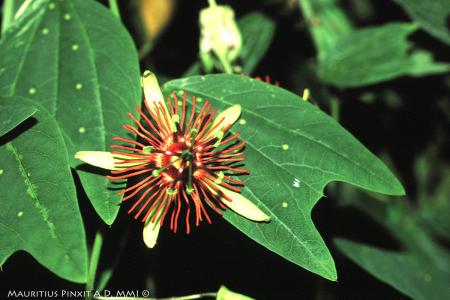
SUBGENUS: decaloba
SUPERSECTION: decaloba
SECTION: decaloba
GEOGRAPHICAL DISTRIBUTION OR ORIGIN:
Costa Rica.
MINIMUM TEMPERATURE: 10 °C
IDEAL MINIMUM TEMPERATURE: 12 °C
ETYMOLOGY: Dedicated to the Texan entomologist Lawrence E. Gilbert, living, expert in passion flowers and butterflies that frequent them.
NOTES: Chromosomes: 2n=12.
DESCRIPTION:
For about ten years now, it has been possible to admire the beautiful leaves of a recently acquired species, P. gilbertiana. From it, through the crossing with P. jorullensis, P. 'Sunburst' was obtained, a now well-known and widespread hybrid.
P. gilbertiana, of Costa Rican origin, has long, narrow bilobate leaves. The lobes are pointed and short. The leaf thus acquires a 'forked' or 'dovetail' appearance. The two lateral veins, which run along the leaf from the petiole to the apex, and the central vein are marked by irregularly outlined light yellow bands, which contrast nicely with the dark green of the blade. Two rows of leaf glands, running parallel to the lateral veins just outside the coloured zone, mark the area between the 3 veins themselves.
The leaves are of a decent size: 13-14 cm in length and about half that in width.
The star-shaped flowers, only 2 cm in diameter, have yellow-green sepals and petals. The corona is light yellow.
This passionflower is to be cultivated in pots and sheltered during the winter period since, like almost all those belonging to the subgenus Decaloba, it suffers at temperatures below 10°C. I believe it can be used as a houseplant as it can adapt to low light situations. However, it prefers good light and, in summer, full sun. A rich and well-fertilised multipurpose soil is ideal for its cultivation.
Propagation
by cuttings is simple and offers sure results. Alternatively, seeds can be
used.